Learning objectives
- Understand biology and identification of white sweetclover
- Understand impacts of white sweetclover and mitigating impacts with IPM goals
- Understand prevention strategies for white sweetclover
- Understand control strategies for white sweetclover
- The species
a. General description, Biology, invasive potential
White sweetclover is a biennial forb in the pea family that is native to Eurasia. Pea family plants are able to fix their own nitrogen with an association with mycorrhizal fungi that reside in nodules on the roots. Nitrogen fixation allows species like white sweetclover to grow in areas of low fertility, and is a common desirable trait for crops especially if they will be used as a soil building green manure.
White sweetclover produces many seeds that are present in pods. The seeds are relatively large, and float as their main means of natural long distance dispersal. Otherwise sweetclover is not particularly suited to long distance dispersal without the aid of animals or human activity. Seeds could be spread through gravel, soil, forage, or straw. Extensive seed banks can form, and seed are viable for up to 70 years making ongoing management after infestation necessary. Sweetclover tends to grow on roadsides, waste areas, and gravel pits. Sweetclover has spread to natural areas, including glacial river floodplains, where it is known to be detrimental to the establishment of some native species because it increases the amount of shade when growing at high numbers (Spellman, 2011).
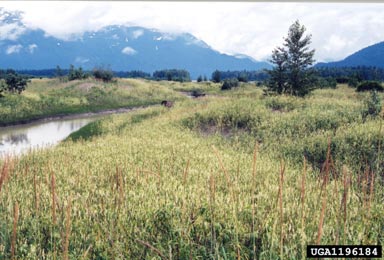
b. Identification
White sweetclover is a biennial forb meaning it flowers in its second year before it dies. In Alaska some sweetclover has been observed flowering in the first year of growth. During the first season of growth plants are typically short and may go unnoticed. In the second season of growth plants will grow tall (2-5 feet) with a stout stem.
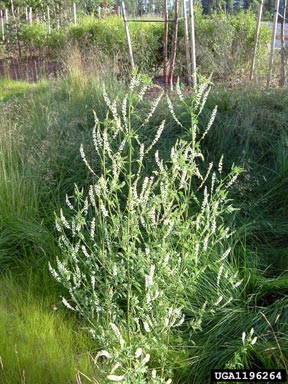
Leaves are trifoliate and arranged in an alternate pattern. Leaves have serrated edges that can help distinguish it from other trifoliate clovers when it is small. Flowers are white and are arranged on many flowered racemes. The resulting fruits are pods with 1 seed per pod.
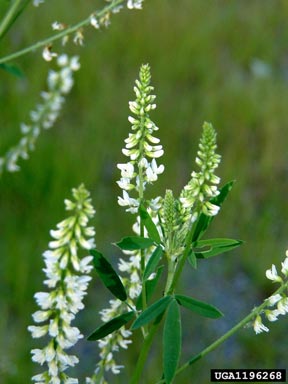
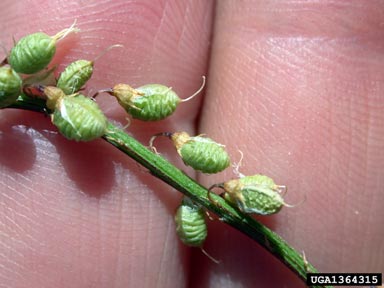
Fruit pods of white sweetclover. (Mary Ellen (Mel) Harte, Bugwood.org)
c. Similar species and native look-a-likes
Species similar to white sweetclover include yellow sweetclover which is also non-native. While yellow sweetclover grows in similar roadside habitats it has not been observed growing in glacial river floodplains as white sweetclover has. Yellow sweetclover differs from white sweetclover with its yellow flower color, and some taxonomists classify white and yellow sweetclover as the same species. In its first year of growth sweetclover may be mistaken for other trifoliate clovers. It is distinguished by its serrated leaves and flowers on racemes when present.
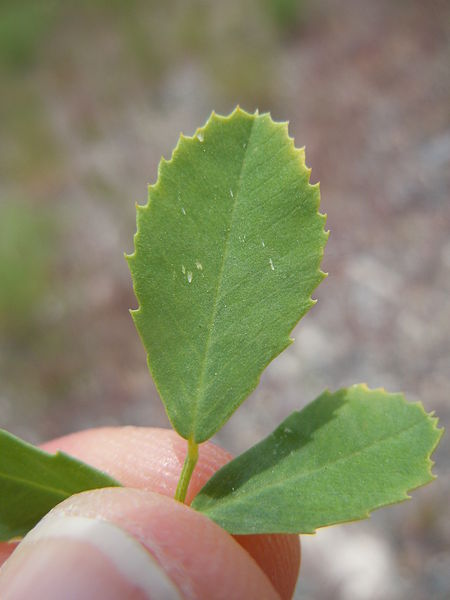
d. Introduction to North America and Alaska
White sweetclover was introduced to Alaska for agricultural experimentation as a forage crop, soil builder, and for honey production. Sweetclover nectar is highly attractive to bees. It is unclear how sweetclover began to spread in Alaska. Some believed it was deliberately planted by the Department of Transportation, but there are no records to verify this. It also may have spread to roadsides from plantings and spread along roadsides and gravel pits because it is particularly well adapted to infrequent major disturbances that clear trees in otherwise low nutrient roadside soils and gravel. Sweetclover is known to spread along roadsides, and later will invade glacial river floodplains in Alaska beginning at the road river interfaces.
To understand more about the interaction between some weeds and roadsides view this video clip.
